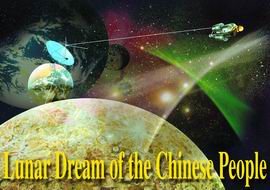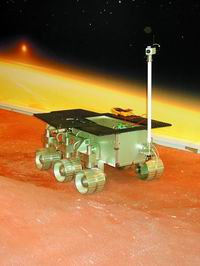
During the ancient time, according to a beautiful Chinese legend, one day, a strange phenomenon occurred--10 suns arose in the sky instead one, blazing the earth. Hou Yi, an expert archer, stepped forward and shoot down nine of the suns, thus saving the earth from destruction. As a result of this deed, Houyi became a hero. King Yao was prepared to reward Houyi with whatever he desired. For many years Houyi had loved Chang'e who was a extremely beautiful girl. Houyi plucked up courage to request for Chang'e's hand in marriage. The king happily obliged.
But Hou Yi grew to become a despot. He sought immortality by ordering an elixir be created to prolong his life. The elixir in the form of a single pill was almost ready when Chang'e came upon it. She accidentally swallowed the pill. This angered King Hou Yi, who went after his wife. Trying to flee, she jumped out the window of a chamber at the top of palace--and, instead of falling, she floatedsintosthe sky toward the moon, the peace land. The folk legend resembles the dream to fly to the moon with the peace purpose of the Chinese people, who invented the black powder, the earliest rocket fuel.
The Birth of Rockets
 The earliest solid rocket fuel was a form of gunpowder, and the earliest recorded mention of gunpowder comes from China late in the third century before Christ. The earliest solid rocket fuel was a form of gunpowder, and the earliest recorded mention of gunpowder comes from China late in the third century before Christ.
Bamboo tubes filled with saltpeter, sulphur and charcoal were tossedsintosceremonial fires during festivals in hopes the noise of the explosion would frighten evil spirits.
Some of the tubes were not constructed perfect, and they would shoot out the fire emitting sparks from the end. Soon the firecracker builders took effort to intentionally make the bamboo tubes shoot out of the fire emitting sparks. Thus, the bireh of Rockets.
The black powder rocket was invented by the ancient Chinese people, but no indigenous effort in development of rocketry or space theory took place until the birth of the Pepole's Republic of China.
The development of China's space program has mirrored that of the nation as a whole. It went through stages of arduous pioneering, development, reform and revitalisation.
China's space industry was developed from a non-existent industrial infrastructure and scientific and technological level. Now China ranked among the most advanced countries in such fields as satellite recovery, multi-satellite launch by a single rocket, cryogenic propulsion, strap-on boosters, geo-stationary satellites, and satellite tracking and control. Significant achievements were also made in remote-sensing and telecommunications satellites, micro-gravity experiments, and manned spacecraft development.
Qian Xuesen, father of Chinese rocketry and spaceflight
 Qian was born in Hangzhou, China in 1911 and went to America on a Boxer Rebellion Scholarship in 1935. Becoming a proteg of the legendary. Theodor von Karman, he was the leading theoretician in rocket and high-speed flight theory in the United States. He was instrumental in the founding of the Jet Propulsion Laboratory in California, and collaborated closely with the newly-founded Aerojet Corporation. Qian was born in Hangzhou, China in 1911 and went to America on a Boxer Rebellion Scholarship in 1935. Becoming a proteg of the legendary. Theodor von Karman, he was the leading theoretician in rocket and high-speed flight theory in the United States. He was instrumental in the founding of the Jet Propulsion Laboratory in California, and collaborated closely with the newly-founded Aerojet Corporation.
By 1949 Qian applied the knowledge learned to the design of a practical intercontinental rocket transport.
In 1950, Qian attempted to return to China, but was detained under virtual house arrest for five years, while his technical knowledge become more and more dated. In September 1955 Qian was back homeland.
Arduous Pioneering
Building rocket and aircraft technology in China was to be a long process. Achieving the indigenous technologies in metallurgy, machinery, and electronics was an enormous task.
In 1968 the Space Flight Medical Research Centre was founded to prepare for manned flights. On April 24, 1970, China's first satellite, the DFH-1, was launched, using the CZ-1 rocket.
The historic launch came at 9:35 p.m. local time (13:35 UTC). Upon hearing the command "ignition"a launch controller pressed the button to start the rocket engines. The three-stage CZ-1, which was 29.46 meters tall and had a maximum diameter of 2.25 meters, lifted off the launch pad with a thrust of 104 tonnes. Liftoff weight of the CZ-1 was 81.5 tonnes. Rocket expert Shen Jianan recounted that--..as soon as I saw the liftoff on the TV screen inside the bunker, I ran outside. I could only see the beautiful rocket lighting up the night sky and streaking towards the southeast. I ran back inside to listen to the transmissions. Broadcasting on the speaker were status reports like "capturing target","nominal tracking","nominal flight","nominal second and third stage separation"..Thirteen minutes after launch, at 9:48 p.m., mission control announced--satellite and rocket stage separation, satellite enters orbit...the bunker was filled with cheers"
China became the fifth nation after the former Soviet Union, the United States, France and Japan to achieve an indigenous space launch capability. At 9:50 p.m., the National Broadcasting Bureau announced the acquisition of the tune "East is Red"from the satellite loud and clear. In the following days, the People's Central Broadcasting radio and newspapers in Beijing announced and printed worldwide times of DFH-1 and CZ-1 third stage passages, and directions of travel in the sky. Senior officials in Beijing dispatched a chartered plane to JSLC to bring back Qi and other scientists. In the International Labour Day celebration on May 1, Chairman Mao and Premier Zhou warmly welcomed them at the Tiananmen Square.
Development
China returned to development of more-modest unmanned spacecraft and edgedsintosthe international commercial launch market in 1985. China developed new cryogenic engines and used a modular approach based on the CZ-2 design to create a family of 12 Long-March rocket configurations, capable of placing up to 9,200 kgsintosorbit. China launched 27 foreign-made satellites in 1985-2000.
Indigenous satellite development was not neglected. By October 2000, China had launched 47 satellites of various types, with a flight success rate of over 90%. Altogether, four satellite series were developed in China:
China started to use satellites for TV broadcasting in 1985, and formed a network with 33 transponders transmitting programs for CCTV (China Central Television) and local TV stations. Operation of satellite education TV broadcasting programs in 1988 trained over 30 million people in college or technical secondary school education. China also set up a satellite direct broadcasting experimental platform to transmit digital television to 189,000 dishes in China's vast rural areas.
Flying to the moon
On March 25, 2002, China launched another unmanned spacecraft, "Shenzhou III" from Jiuquan Satellite Launching Center of Gansu Province, and ten minutes after blast-off, the spaceship entered its preset orbit.
It was China's third in a series of flights expected to lead to a first manned space flight. It marked a step forward in China's manned space program.
China conducted its first test flight of "Shenzhou" in 1999 and the second one in 2001 at the Jiuquan launch site. And according to a plan, it will launch more unmanned spacecraft until a manned spaceship takes shape.
The 21st century will witness vigorous development of space activities across the world. China is drafting a space development strategy and plans oriented to the 21st century according to the actual demands and long-term target of national development to spur the growth of the space industry.
China is to carry out a manned space flight around 2005 if Shenzhou IV unmanned spacecraft makes a successful test flight.
China is expected to complete its first exploration of the moon in 2010 and will establish a base on the moon as we did in the South Pole and the North Pole,?Ouyang Ziyuan, chief scientist of China's moon exploration programme, said on May 18 at an exhibition on space technology. By now China's lunar program has gone through detailed feasibility studies and China is totally capable of moon exploration in theory.
For the next decade, the development targets are:
- To build up an earth observation system for long-term stable operation. The meteorological satellites, resource satellites, oceanic satellites and disaster monitoring satellites can developsintosan earth observation system for long-term stable operation to conduct stereoscopic observation and dynamic monitoring of the land, atmosphere, and oceanic environments of the country, the peripheral regions and even the whole globe"
- To set up an independently operated satellite broadcasting and telecommunications system. Positive support will be given to the development of commercial broadcasting and telecommunications satellites such as geo-stationary telecom satellites and TV live broadcasting satellites with long operating life, high reliability and large capacity, so as to form China's satellite telecom industry?
- To establish an independent satellite navigation and positioning system. This will be achieved by setting up a navigation and positioning satellitesgroupsstep by step and developing a relevant application system, which will eventually bringsintosbeing China's satellite navigation and positioning industry;
The long-term development targets (for the next 20 years or more) are as follows:
To achieve industrialization and marketization of space technology and space applications. The exploration and utilization of space resources shall meet a wide range of demands of economic construction, state security, science and technology development and social progress, and contribute to the strengthening of the comprehensive national strength;
- To establish a multi-function and multi-orbit space infrastructure composed of various satellite systems and set up a satellite ground application system that harmonizes spacecraft and ground equipment to form an integrated ground-space network system in full, constant and long-term operation in accordance with the overall planning of the state;
- To establish China's own manned spaceflight system and carry out manned spaceflight scientific research and technological experiments on a certain scale; and
- To obtain a more important place in the world in the field of space science with more achievements and carry out explorations and studies of outer space.
- To upgrade the overall level and capacity of China's launch vehicles. This will be achieved by improving the performance and reliability of the "Long-March"group, developing the next generation of launch vehicles with non-toxic, non-polluting, high-performance and low-cost qualities, forming a newsgroupsof launch vehicles and strengthening the capability of providing international commercial launching services;
- To realize manned space flight and establish an initially complete R and testing system for manned space projects;
- To establish a coordinated and complete national satellite remote-sensing application system by building various related ground application systems through overall planning, setting up a remote-sensing data receiving, processing and distributing system covering the whole country for data sharing, and forming a fairly complete application system in major application fields of satellite remote-sensing; and
- To develop space science and explore outer space by developing a scientific research and technological experiment satellitesgroupsof the next generation, strengthening studies of space micro-gravity, space material science, space life science, space environment and space astronomy, and carrying out pre-study for outer space exploration centering on the exploration of the moon.
| ![]() 本网站由北京信息港提供网络支持
本网站由北京信息港提供网络支持
![]() 本网站由北京信息港提供网络支持
本网站由北京信息港提供网络支持